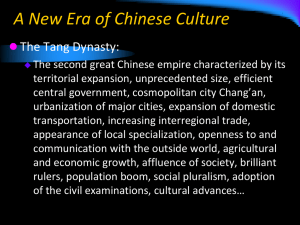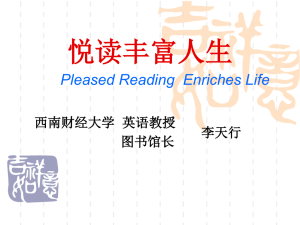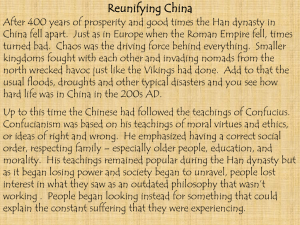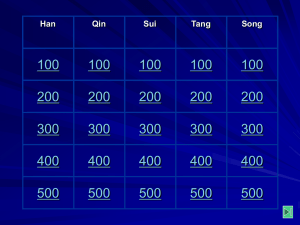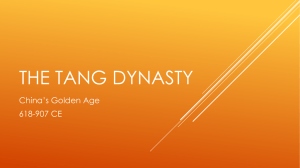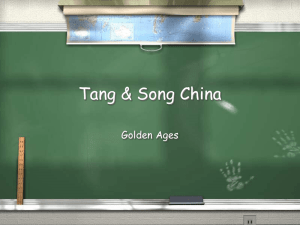Dynasties | Tang Dynasty 618-907
advertisement
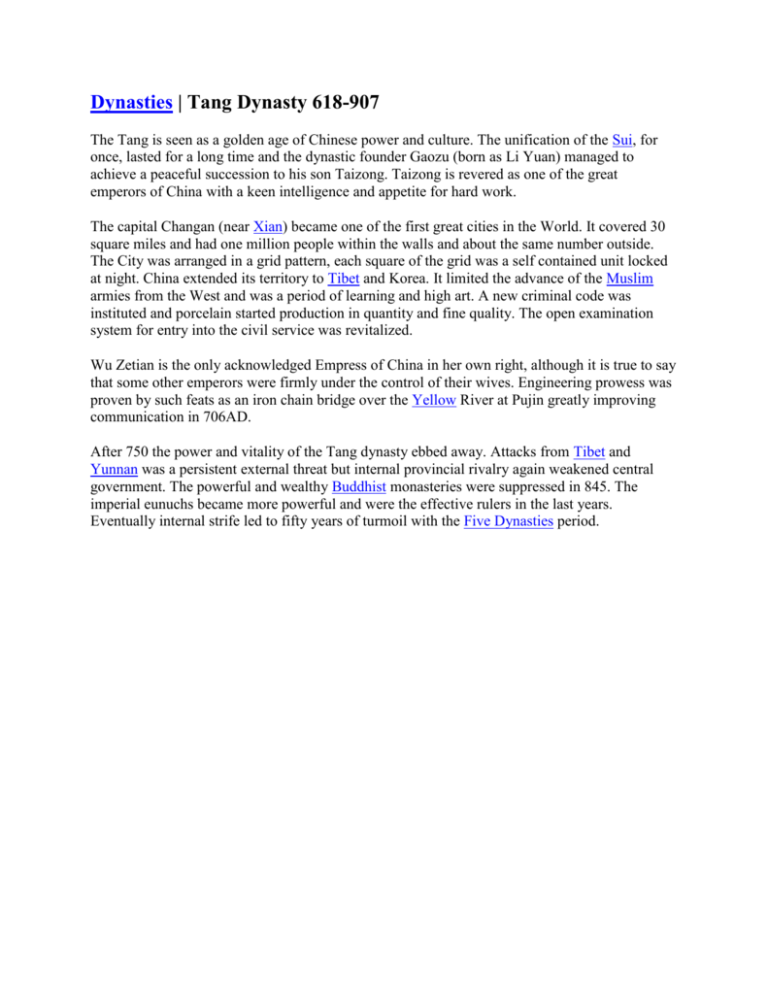
Dynasties | Tang Dynasty 618-907 The Tang is seen as a golden age of Chinese power and culture. The unification of the Sui, for once, lasted for a long time and the dynastic founder Gaozu (born as Li Yuan) managed to achieve a peaceful succession to his son Taizong. Taizong is revered as one of the great emperors of China with a keen intelligence and appetite for hard work. The capital Changan (near Xian) became one of the first great cities in the World. It covered 30 square miles and had one million people within the walls and about the same number outside. The City was arranged in a grid pattern, each square of the grid was a self contained unit locked at night. China extended its territory to Tibet and Korea. It limited the advance of the Muslim armies from the West and was a period of learning and high art. A new criminal code was instituted and porcelain started production in quantity and fine quality. The open examination system for entry into the civil service was revitalized. Wu Zetian is the only acknowledged Empress of China in her own right, although it is true to say that some other emperors were firmly under the control of their wives. Engineering prowess was proven by such feats as an iron chain bridge over the Yellow River at Pujin greatly improving communication in 706AD. After 750 the power and vitality of the Tang dynasty ebbed away. Attacks from Tibet and Yunnan was a persistent external threat but internal provincial rivalry again weakened central government. The powerful and wealthy Buddhist monasteries were suppressed in 845. The imperial eunuchs became more powerful and were the effective rulers in the last years. Eventually internal strife led to fifty years of turmoil with the Five Dynasties period. The Tang Dynasty was the golden age of Chinese poetry. In the number of poems and variety of poetic forms, the beauty of imagery and broadness of themes, Tang poetry surpassed all that had preceded it. The Complete Anthology of Tang Poetry, edited during the Qing Dynasty (1644 1911), contains over 50,000 poems written by some two thousand poets. The collection provides a magnificent insight into all aspects of the social life of the period. Tang poets are held in high regard and among the most notable are Li Bai, Du Fu and Bai Juyi. Li Bai(712-770) the Immortal Poet, living during the peak of the Tang period, wrote as many as nine hundred poems. He was probably the greatest of the ancient Chinese poets. It is generally agreed that between them, Li Bai and Du Fu elevated the poetic form to a level of power and expression that remains unsurpassed by poets of subsequent generations. His work is characterized by its imaginative and unrestrained expression of feeling. Rated as a romantic poet, his writings are endowed with a deep appreciation of people and their lives. The magnificent scenery he saw and enjoyed as well as the profound expression of his own desires and sorrows are subjects of his work. Du Fu(712-770) The Sage of Poets, lived in a period of change when the prosperity of the Tang began to decline. Having suffered obstacles in his official career, he began to travel around the country and to write poetry. Living as a refugee during the Rebellion of An and Shi gave him a personal empathy with the sufferings of the poor. His work shows a great depth of feeling for the plight of the common people. In 759, Du Fu went to live in Chengdu and it is here that his former residence the Thatched Cottage is open for viewing by visitors. Recording as they do both the military and political situations pertaining at this time, Du Fu's poems are referred to as "the mirror of his time". He is regarded as providing a typical representation of realism in poetry. The most popular of his poems are the Three Officials and Three Leaves. Wang Wei(772-846) A government system supported by a large class of Confucian literati selected through civil service examinations was perfected under Tang rule. This competitive procedure was designed to draw the best talents into government. But perhaps an even greater consideration for the Tang rulers, aware that imperial dependence on powerful aristocratic families and warlords would have destabilizing consequences, was to create a body of career officials having no autonomous territorial or functional power base. As it turned out, these scholar-officials acquired status in their local communities, family ties, and shared values that connected them to the imperial court. From Tang times until the closing days of the Qing empire in 1911, scholar-officials functioned often as intermediaries between the grass-roots level and the government. Bai Juyi(772-846) Bai Juyi was the son of an official. As a young man, he wandered about to escape from the wars and hence suffered from poverty and hunger. Later, after having succeeded in the civil service examinations, he served for fifteen years as an official. He was disliked and ostracized by his noble colleagues and was sent away from the capital to work in remote cities.Bai Juyi wrote almost three thousand poems, his output exceeding that of the other Tang poets. With their themes centring on the important social and political problems, Bai Juyi used plain and simple language that proved enlightening even for those who had not received even the poorest education. He also wrote many lyrics expressing his personal feelings. His long narrative poem The Song of the Pipa Player is among the best known. (A pipa is a musical instrument). Tang Dynasty Viewing the Chinese history record, you will find the Tang Dynasty was the most glistening historic period in China's history. Founded in 618 and ending in 907, the state, under the ruling of the Tang Emperors, became the most powerful and prosperous country in the world. Particularly, in this glorious period, the economy, politics, culture and military strength reached an unparalleled advanced level. Establishment At the end of Sui Dynasty (581 - 618), the whole country fell into chaos due to the tyranny of Emperor Yang; rebellions roused by peasants were everywhere. Resenting Emperor Yang's ruling, the chief officer of Taiyuan - Li Yuan, who was also known as Tangguo Gong (a vassal in Sui Court) raised an army in Taiyuan from May 617. In November of the same year, Li Yuan's army captured the capital city Chang'an (currently Xian) and put a new monarch, Yang You, on the throne as Emperor Gong. Tang Tri-colored Glazed Meanwhile, Li Yuan proclaimed himself Da Chengxiang Pottery (prime minister) and Tang Wang (King of Tang). In 618 after Emperor Yang was killed by his chancellor, Yuwen Huaji, Li Yuan seized the chance to proclaim himself emperor and changed the state title into Tang, still with Chang'an as the capital city. Glorious Period The first glorious period was from 627 to 649 when the Tang Dynasty was just set up and its national strength was recovering from the previous weak condition. Under Emperor Taizong Li Shimin's wise governing, the national strength and social development reached an unparalleled prosperity - economy and commerce flourished, the social order was stable, corruption never existed in the court and the national boundaries were even open to foreign countries. Mural of a Banquet, Tang Dynasty Agate Cup with Animal Head, Tang Dynasty After Li Shimin died, the throne passed to his ninth son Li Zhi who was later crowned as Emperor Gaozong and married Li Shimin's imperial concubine Wu Meiniang. Wu Meiniang was officially named Wu Zetian and afterwards became the empress. Actually it was Wu Zetian who had the real power during Emperor Gaozong's reign since the emperor suffered from bad health. After Li Zhi died, Wu successively enthroned and dethroned her two sons - Li Xian and Li Dan. In 690, disregarding the objections and criticisms of all chancellors, Wu Zetian proclaimed herself Emperor Shengshen and established a new dynasty - Zhou, which lasted for 15 years. During her reign, the state economy continued to develop rapidly. In 705, a coup broke out which brought one of the former emperors, Li Xian, to the throne as Emperor Zhongzong. However, Emperor Zhongzong's ruling was manipulated by his wife, Empress Wei. In 710, plotting to be the second woman emperor, Empress Wei along with Princess Anle poisoned Zhongzong. At that time, Li Longji (son of Li Dan) launched a coup with the assistance of his parental aunt Princess Taiping, killing Empress Wei and Princess Anle. After that, Li Dan was crowned as Emperor Ruizong. The second glorious period was during Emperor Xuanzong's reign. In 712, Emperor Ruizong abdicated and Li Longji was enthroned as Emperor Xuanzong. Under his ruling, the national economy, politics and culture all developed rapidly and the social development entered a new heyday. In that period, Chang'an City was the largest and the most prosperous metropolis in the world. Since the title of Xuanzong's reign was Kaiyuan, that period was called the Heyday of Kaiyuan, in which the Tang Dynasty reached its summit of prosperity. Bronze Mirror, Tang Dynasty White Porcelain, Tang Dynasty Invention Gunpowder is one of the four important Chinese inventions. It was invented by the Chinese at around the seventh and the eighth centuries, according to some records made in the Tang Dynasty. At that time, many Daoists would practise alchemy, that is, mixing different kinds of materials together for refinery, trying to obtain elixir from the process. However, accidents occurred when the Daoists tried to refine the powdered mixture of charcoal, sulfur and saltpeter. Explosions were caused. Later on, more and more alchemists who followed the same method got hurt or burnt by the explosions caused. The Chinese then discovered that the mixture of charcoal, sulfur and saltpeter in a fixed proportion is highly flammable. They called this "medicine" (the ancient Chinese treated charcoal, sulfur and saltpeter as medicines) the "fire medicine", which became the ancestor of gunpowder widely used nowadays. Development To the Chinese living in the Tang Dynasty, gunpowder was nothing more than an entertaining accessory. They used it to making beautiful fireworks for celebration of important festivals and official ceremonies. It was not until the eleventh century that the Chinese learned to apply the gunpowder for warfare. Several types of gunpowder were produced by the Chinese for different applications, e.g. the black gunpowder for making explosive grenades and bombs which were to be hurled to enemies using catapults, another type of gunpowder for large guns and cannons, and the other for making signal rockets and flame throwers. In the Northern Song Dynasty, flammable weapons such as arrows with small bombs, cannons and grenades were produced. When it came to the Southern Song Dynasty, gunpowder was widely used in wars to make explosive weapons, such as cannons and guns filled with small arrows, metal balls and gunpowder. During the Yuen and Ming Dynasties, gunpowder was further developed. Apart from cannons made of steel and copper, gas-propelled rockets were also available. To the twelfth century, the Chinese had already managed to use gunpowder to make different types of flame. These were usually used to produce a joyful atmosphere in festivals. arrow with a bomb at the end a "gun" Dissemination The Mongols in the north of China gradually learned the use of gunpowder. During their three conquests in the West, their use of gunpowder had brought them victories over their enemies. This surprised the Europeans and caught their attention. The Europeans then obtained the knowledge of making and using gunpowder. Apart from making weapons, the Europeans further widen gunpowder's application onto mining and building roads, which tributes much to the improvement in living condition and modern technology enjoyed by modern people. Tang Dynasty and Bi Sheng The technique of printing with carved wood blocks appeared about the 7th century, early in the Tang dynasty. Block printing reached it's golden age during the Song dynasty which was in the years 960-1279 as the imperial patronage encouraged the publication of large numbers of books by the central and local governments. Movable type was first invented by Bi Sheng of the Song dynasty between the years 1041 and 1048. This invention was recorded by his contemporary Shen Kuo which recorded it in his Dreampool Essays. During the 13-14th centuries, the agriculturist Wang Zhen made an important contribution to the development of movable type printing. Diplomatic Relations Compared with the previous dynasties, the Tang Dynasty made greater progress in dealing with diplomatic relations. Since more and more states began to establish diplomatic relations with Tang, the economical and cultural exchange between China and some foreign countries developed rapidly. Tang's World Status Having a good reputation in the contemporary international community, China in the Tang Dynasty became a world Stone statues of 61 foreign officials center of economical and cultural exchange. in Qianling Mausoleum, Tang Dynasty During that period, the transportation was efficient and well managed. Besides the complete land network extending in all directions, many sea routes were opened up for marine traffic. Principally, three routes were exploited to Japan, respectively starting from Penglai (in current Yantai) in Shandong Province, Huai'an and Yangzhou in Jiangsu Province. There were also sea routes leading to Southeast Asia, West Asia, Egypt and Eastern Africa. Attracted by the prosperity of Tang, envoys, businessmen, scholars, artists and monks from more than 70 countries came to study or to do business in capital Chang'an (currently Xian),which, before long, turned into an international metropolis. Relationship with Japan The diplomatic relations between Tang and Japan included exchange of culture, politics, education and language. During the Tang Dynasty, Japan had just established the feudal system and admired Tang's prosperity. So Japan started the Envoy-dispatching System and sent a large number of envoys to China. Additionally, many Japanese students came to China to study. When those envoys and students returned to Japan, they not only spread the knowledge they learnt in China but also took home some cultural relics of Tang, such as musical instruments, folding screens, copper mirrors and broadswords. In return, many Chinese Buddhist monks also traversed the sea to Japan, making contributions to cultural exchanges between the two countries. Particularly, a Buddhist monk named Jian Zhen, along with his disciples, made six attempts before succeeding at the arduous journey to Japan. In his seventies and being blind, Jian Zhen spread the Buddhist temple architecture, the art of sculpture and painting to Japan. As a master of medicine, Jian Zhen also made great contributions to the Japanese medical development. In the field of politics, education and language formation, Japan modestly learnt a lot from Tang society. Referring to the Juntian Zhi (land equalization policy) and Zuyongtiao Zhi (tax modification system) of the Tang Dynasty, Japanese rulers carried out new land laws and their own Zuyongtiao System. Its official system and law system also imitated that of the Sui and Tang dynasties. In education, the Mikado of Japan set up universities, with all the subjects similar to that of the Tang Dynasty. Before the 8th century, in language, the Japanese people used Chinese characters as the expression tools. Later, a Japanese student and a knowledgeable monk created the Japanese kana alphabet, namely Hiragana and Katakana. Additionally, Japanese vocabulary and grammar were deeply influenced by those of Chinese language. Relationship with Gaoli, Xinluo and Baiji At the beginning of the Tang Dynasty, the Korean Peninsula was occupied by three countries Gaoli, Xinluo and Baiji. During that period, Gaoli and Baiji often united to attack Xinluo, which made Xinluo resort to the Tang court. At first, the Tang court got on well with all three countries and sent envoys there. In order to help Xinluo to fight against the other two countries, Emperor Taizong began to attack Gaoli in 644. However, none of the expeditions to Gaoli succeeded before Emperor Taizong's death in 649. During Emperor Gaozong's reign, Tang' army made alliance with Xinluo's army and defeated Baiji. In 668, Tang's army defeated Gaoli, capturing its capital city, Pingrang. Before long, under the pressure of domestic ethic minorities and former Gaoli's military force, Tang's army gradually retreated from Korean Peninsula. In 675, Xinluo unified the Korean Peninsula. Since then, the Tang court and Xinluo had established a friendly relationship. Among other foreign countries having diplomatic relations with China, Xinluo had the most students studying in Chang'an (currently Xian) and had the largest trade volume with China. Meanwhile, both countries benefited from cultural exchanges. Tang envoys to Xinluo conveyed silk, porcelain, Chinese tea and engraving typography, while Xinluo's envoys came to China, bringing medicinal materials, handicraft articles, bezoar, Korean ginseng and Korean music. Relationship with Ethnic Minorities From beginning to end, the Tang Dynasty and some other ethnic minorities, including Tujue, Tobo, Xue Yantuo and Nanzhao, formed an indivisible relationship. Soon after the founding of the Tang Dynasty, battles between Tang court and Tujue were launched; during the glorious period, Tang had more than once married princess to Tobo leaders; in late Tang Dynasty, Tang and Nanzhao started war affairs. Generally speaking, there were four main policies by which Tang court dealt with ethnic groups. The first one was the military expedition, dealing with the ethnic Aristocrats who harassed Tang's border areas. The second one was letting the ethnic minority leaders govern their local areas, along with the management of Tang court's administrative bureau. The third one was marrying Tang princess to ethnic groups' leaders, enhancing the bilateral feelings. The fourth one was trading and paying tribute to each other. Tang used to trade Silk and paper with Huihe's horses. Painted Pottery of Foreign Horsemen, Tang Dynasty Relationship with Tujue The relationship between Tang and Tujue experienced a process from hostilities to friendliness. After the founding of the Tang Dynasty, the aristocrats of Tujue frequently attacked the Guanzhong area (the central Shaanxi, pressing on towards Chang'an (currently Xian). In that situation, Emperor Taizong adopted a positive defensive stance. In 629 when the internal conflicts of Tujue broke out, hundreds of thousands of Tang soldiers were dispatched to attack Tujue tribes, which gave a fatal blow to the Tujue group. After the downfall of the Tujue, the Tang court set up four provincial military institutions in Tujue's previous area where more than a hundred thousand Tujue people were settled. Meanwhile, six 'zhou' (province in Tang Dynasty) were established in currently Inner Mongolia. Former headmen of the Tujue were still appointed by the Tang court to govern their local area. It was said that approximately ten thousand Tujue families had migrated to capital Chang'an. Additionally, more than a hundred Tujue aristocrats were nominated as generals and some other high military officers. Relationship with Xue Yantuo and Huihe After Tang captured Tujue, another two ethnic minorities - Xue Yantuo and Huihe - established their regime in the Mobei (desert area in North China) area. Xue Yantuo was made up of the Xue group and the Yantuo group. Xue Yantuo and Huihe both belonged to the Tiele ethnic group. Compared with Huihe, Xue Yantuo had a much stronger military force. In 628, the leader of Xue Yantuo, Yi Nan, defeated four generals of Tujue and was honored as Khan. Later, Emperor Taizong conferred on him the title of Zhenzhu Pijia Khan and made alliance with Xue Yantuo to fight against Tujue. Since the downfall of Tuejue, Xue Yantuo had become the main power in the Mobei area. In 645 Yi Nan died and the throne was passed to Duo Mi, a tyrant whose ruling caused domestic chaos. In 646, both Huihe and Tang launched a war against Xue Yantuo, killing Duo Mi and ending the Xue Yantuo regime. Later, Huihe and some other tribes that belonged to the Tiele group attached to the Tang Dynasty. In 647, Emperor Taizong divided the Mobei area into six 'fu's and seven 'zhou's. During that period, Tang's administrative region expanded to the entire Mobei area and all the local ethnic leaders honored Emperor Taizong as 'Tian Khan' (king of the sky). Relationship with Tubo Tubo was an ethnic group which formed on the Tibetan plateau. Ever since the founding of Tubo regime, hereditary system was followed. After several generations' ruling, Tubo society gradually turned from a primitive society into a slavery society and the social productivity developed rapidly. In 629, a young headman aged thirteen and named Songtsan Gambo began to rule his group. In his ruling, the whole of Tibet was unified and the Tubo Dynasty was founded. It was in his reign that contact between Tang and Tubo was initiated and reached an unprecedented level. In order to propose marriage towards Tang, Songtsan Gambo sent an envoy with copious gold and treasures to Chang'an in 640. Willing to make friendly relationship with Tubo, Emperor Taizong agreed to marry Wencheng Princess with Songtsan Gambo. Following the marriage of Wencheng Princess and Songtsan Gambo, the economical and cultural exchange between Tang and Tubo had been greatly accelerated. When the princess went to Tubo, she carried many vegetable seeds, handicraft articles, brewing and textile techniques, which had helped to improve Tubo's agriculture and handicraft industry. Meanwhile, merchants from Tubo bought lots of silk, paper and military arrows from the Tang Dynasty. An important thread that linked Tang cultural and Tubo culture was the faith of Buddhism. The formation of Tubo's Buddhism was based on Tianzhu (currently India) Buddhism, Nipoluo (currently Nepal) Buddhism and Buddhism from Tang. Among them, Buddhism from Tang was more suitable to Tubo's local culture. On this basis, Tubo developed its own Buddhist culture which was specifically the predecessor of Tibetan Buddhism. Historical records clarify that when Wencheng Princess entered Tubo, she also brought a figure of Sakyamuni and 360 Buddhist classical sutras with her. Additionally, Tubo used to send envoys to visit Tang's temples including Buddhist temples in Wutaishan Mountain and Da Ci'en Temple in Big Wild Goose Pagoda. Later, Tubo people built their own Buddhist temple - the Jokhang Temple in current Lhasa. Relationship with Nanzhao During the period of Sui and Tang Dynasties, many ethnic tribes inhabited Yunnan area, among which there were mainly two ethnic minorities called Wuman and Baiman. In 7th century, Wuman invaded Baiman, thus six 'zhao's were founded. (According to Wuman people, 'zhao' means king.) Thus six 'zhao's were actually six states. Being one of the six 'zhao's, Nanzhao located in the southernmost area of Yunnan. Furthest from the Tubo Dynsty and receiving threats from Tubo, Nanzhao attached to the Tang Dynasty in its early period. Meanwhile, in order to restrict the power of Tubo, Tang supported Nanzhao to unify all the six 'zhao's. During Nanzhao king Pi Luoge's reign, Nanzhao defeated the other five 'zhao's and established a unified Nanzhao nation, with Dali as its capital. In 738, Emperor Xuanzong of Tang honored Pi Luoge as Yunnan Wang (king of Yunnan area). From then, Nanzhao became the most powerful regime that had been set up by ethnic minorities in Southwest China. The unified Nanzhao society developed rapidly. Due to communication with the Tang Dynasty, the textile, architecture and political system were greatly improved. Textile workers from Chengdu helped a lot with the textile techniques in Yunnan. Most constructions in Nanzhao imitated Tang's architecture. The well-known Three Pagodas in Chongsheng Temple of Dali were designed and built by Tang craftsmen. Referring to Tang's political system, Nanzhao established a well-organized political structure. Especially, following the Tang court, rulers of Nanzhao also carried out Juntian Zhi. However, Nanzhao was a country at war with others. Since the unification, Nanzhao and Tubo endured a long-time struggle until 794 when Nanzhao broke away from the oppression of Tubo. From 830, Nanzhao began to war with Tang, during which period Nanzhao captured Chengdu, causing a great loss to the Tang Dynasty. There were four reasons leading to Tang's decline, among which the dominance of the eunuchs, the separatist regions of Fanzhen and clique conflicts were internal factors while peasants' uprising was the external factor. First, the dominance of eunuchs in the Tang Dynasty was unparalleled in Chinese history, much more rampant than that of Eastern Han Dynasty (25 - 220) and the Ming Dynasty (1368 1644). From the late period of Emperor Xuanzong's reign, the old convention that eunuchs could not be appointed as high officials was broken. At that time, eunuchs' power began to expand. Especially, the celebrated eunuch Gao Lishi reached a position superior to some princes and ministers. In the reign of Emperor Daizong, the notorious eunuch Li Fuguo grasped the military power and controlled the royal power. Gradually, the power of eunuchs became stronger and stronger. They were able to formulate the national policy, to appoint and remove court officials and to enthrone and depose emperors. As the dominance of eunuchs became serious, the military power of central regime was weakened. Additionally, some wise-minded chancellors were hard to express their ideas. What is more, power struggles between eunuchs and chancellors greatly weakened the ruling of the central regime. Second, the separatist regions of Fanzhen were another major problem in the late period of the Tang Dynasty. Actually, the separatist regions of Fanzhen originated from the set-up of Jiedushi (regional military governors). In order to safeguard the border areas, rulers of Tang used to set up many institutions called Jiedushi at the frontier. After the An Shi Rebellion broke out, the Tang court set up more regional Jiedushi to defend the central regime. With much administrative rights and military power, those Jiedushi gradually turned into many separatist regimes called Fanzhen. In competing for the farmland and labor, battles between Fanzhen and the central court constantly broke out. To some extent, all these Fanzhen regimes became small kingdoms whose military forces were only responsible for themselves. This had threatened the unification of the whole country. Third, the conflicts between the different cliques were an indispensable factor that caused the decline of Tang. The court officials of Tang were mainly made up of two groups. One group was from the traditional noble class while the other group came from the civilian class. Due to different class origin and political status, these two groups respectively formed their own parties. In discussing the state affairs, these parties usually held different political views and adopted disparate policies. In order to be superior to the other group, all these parties were entangled with power struggles. As a result, all these internal disputes broke down the power of the central regime. The last one was peasants' uprising which was the only external factor that directly led to the decline of Tang. In the late Tang Dynasty, the land annexation was quite serious. Under the oppression and exploitation of the landowners, peasants endured a hardship. Because of the years of war, peasants were imposed more tax. Besides, eunuchs forcibly occupied peasants' farmland and extorted their money. When it came to Emperor Xizong's reign, the natural disaster raged for years and the output of food decreased abruptly, but the Tang court still imposed much tax on peasants. Finally, peasants' uprising broke out just like the turbulent flood that could not be restrained. Especially, Huang Chao Uprising was a large-scale peasant's rebellion which greatly shook Tang's regime. After the heavy blow of Huang Chao Uprising, the Tang Empire started to go to rack and ruin. Economy in Earlier Stage The social economy in the earlier period of the Tang Dynasty underwent a rising process of recovery, development and prosperity. In particular, under the Zhen Guan Reign and the heyday of Kaiyuan, the national economy reached an unprecedented advanced level. Agriculture: Since the collapse of the Sui Dynasty (581 - 618), productivity had been severely damaged and the national economy was in paralysis. After the Tang Dynasty reunified the whole nation, Emperor Kao Tsu paid much attention to develop agriculture and successively implemented a series of reforms, such as Juntian Zhi (Land Equalization System), and Zuyongdiao System. In this way, the peasants' burden was lessened and production efficiency was improved. As a result, farm tools and agricultural technique were improved. In addition, many irrigation works were completed soon after the foundation of the Tang Dynasty, which contributed to the rapid development of agriculture in Zhen Guan Reign and the heyday of Kaiyuan. The economy was very great in power. Iron Ploughshare, Tang Dynasty Tri-colored Glazed Pottery, Tang Dynasty Handicraft Industry: Because of the great progress in agriculture, surplus labor appeared which spurred the handicraft industry. In all areas of technique, category, or industrial scale, the development of the handicraft industry in Tang Dynasty surpassed that of the previous dynasties. In particluar textile technology reached a fairly advanced level. The technique of silk making became refined and delicate. The ceramic industry also entered a new phase. Besides celadon porcelain, white porcelain and Tri-colored Glazed Pottery were also invented. Some other kinds of manufacturing, including papermaking, tea-leaf processing, metallurgical industry and shipbuilding also thrived in that period. Commerce: Both the rapid development of agriculture and the handicraft industry provide impetus for the prosperity of domestic business and foreign trade. The main commodities included foodstuffs, salt, spirits, tea, medicine, textiles, gold or silver ware and some daily items. A large number of commercial cites sprang up, such as Lanzhou, Chengdu, Guilin, Hangzhou as well as the capital Chang'an (currently Xian) and the auxiliary capital Luoyang. Special markets were set up in those cities, in which a strict market order ran very well. Meanwhile, due to the opening up of the Silk Road in the Han Dynasty (206 BC - 220 AD), vast quantities of foreign merchants and envoys came to trade in China. This also promoted the development of the marine trade. At that time, Tang ships could traverse the Indian Ocean and reach the Persian Gulf. Merchant ships traded frequently between China and countries in Asia and Africa. Economy in Late Stage Statues of Merchants along the Silk Road Silver Bowl with Gilt Design of Two Lions After the An Shi Rebellion, the economy of Tang Dynasty was seriously damaged. The previous Juntian Zhi and Zuyongdiao System were both destroyed. In order to cure the fiscal crises that had been caused by the rebellion and separatist regimes, a new policy called Double Tax System (named after the imposing times) was carried out. Imposing tax according to wealth, the Double Tax System helped resume the fiscal revenue and set a good example for later tax reforms. The tumult of the rebellion caused residents in northern areas to migrate the South of the Yangtze River which brought a great amount of labor and advanced manufacturing technique to southern areas. Therefore, in later Tang Dynasty, the social economy of southern areas developed rapidly and soon replaced northern areas, becoming the national financial center. Agriculture and handicraft industry in southern areas were much more prosperous than that of northern areas. Meanwhile, many new commercial centers emerged not only in urban areas but also in suburban areas. What was more notable was that the earliest exchange system appeared in that period, showing that China's ancient commodity economy had entered a new phase. The prosperity during the Tang Dynasty profited from its enlightened political system: comprehensive administration and official system, strict legal system, and equitable imperial examination system. Administration System The Tang Dynasty (618 - 907) initiated the organizational structure 'Dao' and 'Fu' to divide the political districts. During Zhen Guan's Reign, the national territory was divided into ten political districts called 'Dao', which increased to 15 in the Heyday of Kaiyuan. The subordinate political districts were called 'Zhou' or 'Fu'. The more subordinate administrative structure was in turn 'Xian' (town), 'Xiang' (five 'Li's), 'Li' (a hundred families), 'Cun' (village), 'Bao' (five families) and 'Lin' (four families). At the end of Kaiyuan reign, there were 328 'Zhou's and 1,573 'Xian's. Official System The official system of the Tang administration involved the central official system and local official system. The central official system followed the Sui Dynasty's (581 - 618) Three Departments and Six Ministries system. In addition, nine 'Si's and five 'Jian's were set up to work with the six ministries. The local official system was in line with the political administrative structures, of which the chief official title were called 'Guancha Shi' (observer of Dao), 'Ci Shi' or 'Tai Shou' (chief officer of Zhou), 'Xian Ling', 'Qi Lao', 'Li Zheng', 'Cun Zheng', 'Bao Zhang' and 'Lin Zhang'. Legal System Compared with any other dynasties in Chinese history, the Tang Dynasty had the most comprehensive and the most detailed legal system. Generally, the Tang legal system included four basic forms, namely, 'Lu' (criminal law), 'Ling' (institutional regulations), 'Ge' (administrative rules) and 'Shi' (formulas of official documents). The Tang Lushu Yi, compiled in the reign of Emperor Gaozong was a representative code of feudal laws, which contained criminal law, law of safeguard and defense, law for imperial officers, law of marriage and census registers. The regulations were fairly complete and the legal provisions were rather concise. Especially, in the early period of Zhen Guan's Reign, Emperor Taizong focused much attention on listening to wise advice while enforcing the law. In this way, a peaceful social order was established, setting up a good example for later dynasties and even for some other imperial states in Asia. Imperial Examination System Displacing the old method of selecting talented people, the imperial examination system was a fairly equitable testing system to select officers for the feudal court. There were usually four subjects existing in different times, including 'Jinshi', 'Mingjing', 'Mingfa' and 'Mingyu'. The examination of the highest-grade was called 'Sheng Shi' (the national exam) which was held annually by the Shangshu Sheng in the capital city Chang'an (currently Xian). Those who were selected to attend Sheng Shi were called 'Ju Ren'. Examinees that passed the 'Sheng Shi' were called 'Ji Di'. Especially, the one who got the first place in the exam was entitled as 'Zhuang Yuan'. All the 'Ji Di's were qualified enough to be further judged by Li Bu who decided if they could be given an official title. Stone Statues of 61 Foreign Officials, Qianling Mausoleum, Tang Dynasty Decline and Ruin In his old age, Emperor Xuanzong was complacent and indifferent to state affairs. Hopelessly, he indulged himself in the beauty of his concubine Yang Yuhuan. Besides, he also appointed some wicked chancellors who corrupted the political order. Meanwhile, troops on the frontiers gradually gathered together and formed a powerful military force. In 755, An Lushan aligned with Shi Siming and launched a rebellion, called the An Shi Rebellion which lasted for eight years and heavily knocked the Tang regime. From then on, the national strength was weakened daily by separatist forces in local areas. Because of the incompetence of the emperors the dominance of the eunuchs and power struggles between chancellors became increasingly intense. Hence the Tang Dynasty declined from generation to generation. In 859, a large-scale peasant uprising launched by Huang Chao again severely attacked the Tang regime. In 907, the last Tang emperor, Emperor Ai was forced to abdicate by Chancellor Zhu Quanzhong, who afterwards changed the state title into Liang, finally putting the ever powerful and mighty Tang Dynasty to an end. Generally, the Imperial Examination System was a progressive examination which allowed intellectuals born in poor families to have the opportunity to become an officer in the court. Speaking from the imperial part, this examination system helped to enhance the centralization of imperial power and to promote the unification of thought. Sources: http://www.ancientchina.co.uk/staff/main.html http://www.travelchinaguide.com/intro/history/ http://www.pbs.org/teachers/connect/resources/865/preview/ http://www.ket.org/artofthehorse/ed/index.htm#menu http://www.usc.edu/libraries/archives/arc/libraries/eastasian/china/toqing.html http://www.bcps.org/offices/lis/models/chinahist/song.html http://www.artsmia.org/art-of-asia/history/dynasty-han.cfm



